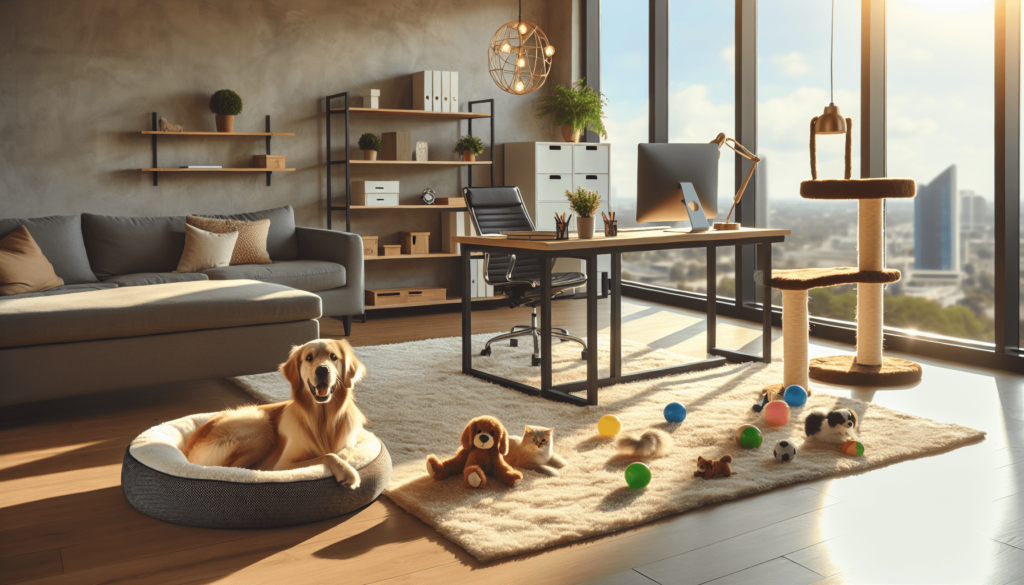Have you ever wondered how to make your workplace more accommodating for your furry friends? Creating a pet-friendly work environment can enhance employee morale, reduce stress, and make the office a more enjoyable place to be. However, it does require some thoughtful planning and considerations to ensure that everyone’s needs are met—including those with pet allergies.

Why Consider a Pet-Friendly Work Environment?
Creating a pet-friendly work environment offers several perks, from improved employee satisfaction to a more vibrant workplace culture. Let’s break this down in more detail.
Employee Well-Being
Having pets at work can significantly reduce stress and increase overall happiness. Studies have shown that interacting with pets releases oxytocin, a hormone that elevates mood and reduces stress levels.
Increased Collaboration
Pets often serve as social catalysts, encouraging conversations and interactions among employees who might not otherwise engage with one another. A pet-friendly office can break the ice and foster collaboration.
Enhanced Company Image
An accommodating work environment can also boost your organization’s image. It showcases your company’s commitment to work-life balance and progressive workplace policies.
Initial Considerations
Before turning your office into a pet paradise, you need to carefully consider various factors to ensure it’s a good fit for your company culture and logistics.
Survey Employee Opinions
Gauge the interest and concerns of your team by conducting a survey. Ask questions about their comfort with animals, any allergies they may have, and suggestions for policies. This will provide a clear understanding of how receptive your team is to the idea.
Sample Survey Questions:
| Question | Response Options |
|---|---|
| Are you interested in a pet-friendly office? | Yes / No / Maybe |
| Do you have any pet allergies? | Yes / No |
| What types of pets do you think should be allowed? | Dogs / Cats / Other (Please specify) |
| Any concerns or suggestions regarding this initiative? | Open-ended |
Analyzing the Workplace Layout
Different office layouts offer varying levels of suitability for pets. Open-plan offices may require designated pet zones, while individual offices might offer more flexibility. Consider how pets will be accommodated and the potential impact on your day-to-day operations.
Company Policies and Liability
It’s essential to establish clear policies to manage and mitigate risks. Define the types of pets allowed, behavior expectations, and responsibilities of pet owners. Consider drafting a liability waiver to protect the company from potential legal issues.
Creating Policies and Guidelines
Policies and guidelines create a framework that maintains harmony among employees and pets. Here are some important aspects to consider:
Types of Pets Allowed
Clearly define the types of pets allowed in the office. Typically, dogs and cats are the most common, but you may also consider small caged animals. However, restrict or prohibit exotic animals for safety and practicality reasons.
Behavior Expectations
Set behavioral standards for pets to ensure a conducive work environment. These can include:
- Pets must be house-trained.
- Pets should be free from aggressive behavior.
- Pets must not create excessive noise.
Pet Owner Responsibilities
Define the responsibilities of pet owners to ensure pets do not become a burden on other employees or the facilities.
- Clean up after their pets.
- Ensure pets are up-to-date on vaccinations.
- Monitor pets at all times.
Creating Pet-Free Zones
To respect those who may not be comfortable around pets or have allergies, designate specific pet-free zones within the office. These can include meeting rooms, kitchens, and break areas.
Making the Office Pet-Friendly
Now that you’ve established policies and guidelines, it’s time to make physical adjustments to accommodate pets.
Pet-Friendly Furniture and Spaces
Introduce pet-friendly furniture like washable rugs and durable office chairs. Consider creating pet-friendly spaces such as:
- Pet Lounges: Areas where pets can relax comfortably.
- Pet Play Zones: Sections where pets can play and interact.
- Feeding Stations: Spots designated for pet meals with easy-to-clean surfaces.
Safety Measures
Implement safety measures to ensure the well-being of both pets and employees.
- Install gates to limit the areas where pets can roam.
- Keep electrical outlets and wires covered.
- Provide a first-aid kit specifically for pets.

Addressing Pet Allergies
One of the key challenges in a pet-friendly office is managing pet allergies. Here’s how you can create an allergy-friendly work environment while keeping it pet-friendly.
Allergy Surveys and Transparency
Before implementing a pet-friendly policy, survey employees to identify those with allergies. Transparency is crucial. Make sure everyone is aware of the details and locations of pet-friendly zones.
Air Quality Management
Invest in high-quality air purifiers to help reduce allergens. Regularly clean HVAC systems and use filters designed to capture pet dander.
Alternative Arrangements
Offer alternative arrangements or remote work options for employees with severe allergies. Flexible work arrangements can foster an inclusive environment.
Training and Orientation
Introduce a training and orientation program for pet owners. This ensures that everyone understands and adheres to the policies.
Pet Owner Training
Pet owners should undergo basic training to understand office etiquette for their pets. Topics could include:
- Managing pet behavior in an office setting.
- Understanding the needs of non-pet owners.
- First-aid measures for pets.
Employee Orientation
Hold orientation sessions for all employees to familiarize them with the new pet-friendly policies and guidelines. Discuss what to do in case of allergies, emergencies, and the importance of mutual respect.
Monitoring and Feedback
Once your pet-friendly workspace is up and running, continuous monitoring and feedback are essential for long-term success.
Regular Check-Ins
Conduct regular check-ins and surveys to gauge how well the policies are working and identify any areas that need improvement.
Sample Check-In Questions:
| Question | Response Options |
|---|---|
| How would you rate your experience in the pet-friendly office? | 1-5 (1 being poor, 5 being excellent) |
| Have you encountered any issues with the current setup? | Yes / No |
| Do you have any suggestions for improvement? | Open-ended |
Addressing Complaints
Be prepared to address any complaints promptly. Whether it’s issues with pet behavior or allergies, a quick and fair resolution will maintain a harmonious work environment.
Successful Examples of Pet-Friendly Offices
Take inspiration from companies that have successfully implemented pet-friendly policies. Here are a few notable examples:
Google’s pet-friendly policy has been lauded for its positive impact on employee morale and productivity. With clear guidelines and designated pet areas, Google ensures a balanced environment for both pet owners and non-pet owners.
Amazon
Amazon allows employees to bring their dogs to work, creating a vibrant and interactive work environment. Their policies cover pet behavior, vaccinations, and employee responsibilities, ensuring a smooth operation.
Etsy
Etsy’s Brooklyn headquarters is another great example, with policies that encourage a pet-friendly atmosphere while addressing potential concerns such as pet allergies through thoughtful planning and designated pet-free zones.
Conclusion
Creating a pet-friendly work environment can significantly enhance workplace morale, foster better collaboration, and improve employee well-being. However, it requires careful planning and consideration to ensure it meets the needs of all employees, including those with allergies. By implementing structured policies, accommodating physical adjustments, and maintaining open communication, you can create a harmonious workplace where everyone feels valued and included.
Summary
By now, you should have a detailed understanding of how to create a pet-friendly work environment. Remember, while the benefits are plentiful, the key to a successful implementation lies in thoughtful planning and inclusive practices. Whether you’re aiming to boost employee morale or simply love the idea of having pets around, these comprehensive guidelines will help you get started on the right paw.
If you’ve ever considered making your office pet-friendly, this article should serve as your ultimate guide to achieving a balanced and happy work environment for all.
